Road signs in Singapore
Road signs in Singapore closely follow those laid down in the traffic sign regulations used in the United Kingdom, although a number of changes over the years have introduced some slight deviations that suit local road conditions (such as fonts). Road signs in Singapore conform to the local Highway Code under authority of the Singapore Traffic Police.
The Highway Code of Singapore Traffic Police is tested during the Basic Theory Test and Final Theory Test at either Ubi, Bukit Batok or Woodlands driving schools. The students are then to find either a school or private driving instructor to learn driving itself. Singaporean road signs depict people with realistic (as opposed to stylised) silhouettes.
Warning signs
Warning signages warn of possible dangers or unusual conditions ahead and alert motorists on the hazards to expect. They are usually shaped as triangles with a red border, mounted on a borderless white backing board.
 General warning sign (old type)
General warning sign (old type)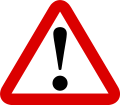 Other dangers; plate beneath will state nature of danger
Other dangers; plate beneath will state nature of danger.svg.png) Restricted Zone ahead
Restricted Zone ahead Electronic Road Pricing (road toll) gantry ahead
Electronic Road Pricing (road toll) gantry ahead Road hump
Road hump Uneven road
Uneven road Road narrows on right (Left if symbol is reversed)
Road narrows on right (Left if symbol is reversed)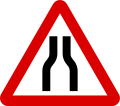 Road narrows on both sides ahead
Road narrows on both sides ahead Two-way traffic crosses a one-way road
Two-way traffic crosses a one-way road Two-way traffic ahead
Two-way traffic ahead Traffic drives on the opposite direction ahead (Keep right and let incoming traffic pass on the left)
Traffic drives on the opposite direction ahead (Keep right and let incoming traffic pass on the left) Lanes merge ahead
Lanes merge ahead Double bend first to left (Right if symbol is reversed)
Double bend first to left (Right if symbol is reversed)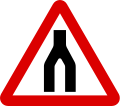 Dual carriageway ends
Dual carriageway ends Crossroads
Crossroads.svg.png) Side road on left
Side road on left.svg.png) Side road on right
Side road on right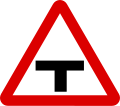 T-junction
T-junction Y-junction
Y-junction Y-junction
Y-junction Traffic merging from left behind
Traffic merging from left behind Road slippery when wet
Road slippery when wet Staggered junction
Staggered junction Steep ascent
Steep ascent Steep descent
Steep descent Quayside or river bank ahead
Quayside or river bank ahead Tunnel ahead
Tunnel ahead Traffic signals in use ahead
Traffic signals in use ahead Gated railway crossing ahead
Gated railway crossing ahead Ungated railway crossing ahead
Ungated railway crossing ahead Indication of a level crossing
Indication of a level crossing Low flying aircraft
Low flying aircraft Roundabout ahead
Roundabout ahead Zebra crossing ahead
Zebra crossing ahead Bend to the right ahead (left if symbol is reversed)
Bend to the right ahead (left if symbol is reversed) Advance warning of a height restriction ahead
Advance warning of a height restriction ahead Children ahead - School crossing patrol
Children ahead - School crossing patrol Animals crossing road ahead
Animals crossing road ahead Pedestrians on road ahead
Pedestrians on road ahead Elderly or blind people ahead
Elderly or blind people ahead Slow down
Slow down Maintain a slow speed to anticipate hazards ahead
Maintain a slow speed to anticipate hazards ahead Bridge with low headroom ahead
Bridge with low headroom ahead Curve alignment marker (Bend to left; right if chevron is reversed)
Curve alignment marker (Bend to left; right if chevron is reversed) Sharp deviation to the left (right if chevrons are reversed)
Sharp deviation to the left (right if chevrons are reversed) Sharp deviation to the left (right if chevrons are reversed) Road
Sharp deviation to the left (right if chevrons are reversed) Road Extended curve alignment marker / 'Waveline' (Bend to left; right if chevrons are reversed)
Extended curve alignment marker / 'Waveline' (Bend to left; right if chevrons are reversed)
Regulatory signs
Regulatory signs either give positive instructions, i.e. Mandatory signs, or indicate a prohibition, i.e. Prohibitionary signs. Many regulatory signs are accompanied by supplementary plates that provides interdependent exceptions to the rule, or indicates additional instruction or information to facilitate understanding of the rule implemented.
Mandatory signs
Mandatory signs are generally circular with a white border and symbol on a blue background. They usually indicate something all drivers must do (e.g. keep left) or a facility available to certain classes of traffic (e.g. pedal cycles only).
 Ahead only (Turning left and right is prohibited)
Ahead only (Turning left and right is prohibited) Turn left ahead (right if symbol is reversed)
Turn left ahead (right if symbol is reversed) Turn left (right if symbol is reversed)
Turn left (right if symbol is reversed) Keep left (Right if symbol is reversed)
Keep left (Right if symbol is reversed) Split-way, i.e. motorists can pass to either side, but either side might not reach the same destination
Split-way, i.e. motorists can pass to either side, but either side might not reach the same destination Route to be used by pedal cycles only
Route to be used by pedal cycles only Route to be used by pedestrians only
Route to be used by pedestrians only Route to be shared by cycles and pedestrians
Route to be shared by cycles and pedestrians Segregated route for pedal cycles and pedestrians (Cycles on left; pedestrians on right). Symbol may be reversed.
Segregated route for pedal cycles and pedestrians (Cycles on left; pedestrians on right). Symbol may be reversed.
The exceptions are the octagonal red STOP sign, the triangular GIVE WAY sign and the various mandatory STOP signs that are circular and have a red border.
 Stop and give way
Stop and give way Give way to traffic on a major road
Give way to traffic on a major road School crossing patrol (sign held by school wardens)
School crossing patrol (sign held by school wardens) Mandatory stop for police checks
Mandatory stop for police checks Mandatory stop for Customs at checkpoint
Mandatory stop for Customs at checkpoint Mandatory stop for private property security checks
Mandatory stop for private property security checks
Prohibitory signs
Prohibitory signs, which generally tell drivers what they must not do, are mostly circular and have a red border. The red ring indicates the prohibition; diagonal bars are used only on signs which prohibit a specific manoeuvre, i.e. banned left or right turns and U-turns, or a certain class of vehicle, i.e. lorries.
 No entry for vehicles in both directions, including pedal cycles
No entry for vehicles in both directions, including pedal cycles No entry for all vehicular traffic
No entry for all vehicular traffic No lorries
No lorries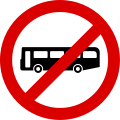 No buses
No buses No pedal cycles
No pedal cycles No motorcycles
No motorcycles No vehicles carrying explosives
No vehicles carrying explosives No vehicles with 3 axles or more
No vehicles with 3 axles or more No sounding of vehicle horn
No sounding of vehicle horn No parking
No parking No waiting on side of road where sign is displayed
No waiting on side of road where sign is displayed No stopping on side of road where sign is displayed
No stopping on side of road where sign is displayed National speed limit applies
National speed limit applies No jaywalking
No jaywalking No jaywalking in the bus park
No jaywalking in the bus park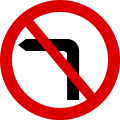 No left turn
No left turn No right turn
No right turn No U-turns
No U-turns No overtaking
No overtaking
Diagonal bars are excluded when restrictions are quantitative in nature, i.e. limits in speed, weight, axle, height and width.
 No vehicles over height shown
No vehicles over height shown No vehicles over width shown
No vehicles over width shown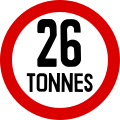 No vehicles over weight shown
No vehicles over weight shown No vehicles over axle shown
No vehicles over axle shown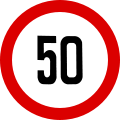 Maximum speed
Maximum speed
in kilometres per hour
Information signs
Information signs are signs that may be mounted to indicate a certain condition or nature of the road ahead that motorists need to take note. They are independent of existing mandatory and prohibitive signs. Such signs are usually white or blue and rectangular in shape.
 Indication of a U-turn lane, on the lane closest to the road divider or carriageway
Indication of a U-turn lane, on the lane closest to the road divider or carriageway One way traffic ahead (Turning left and right is permitted)
One way traffic ahead (Turning left and right is permitted) One-way traffic in direction indicated (left)
One-way traffic in direction indicated (left) Zebra crossing
Zebra crossing Pedal cycle crossing
Pedal cycle crossing Car Park
Car Park End of Car Park
End of Car Park Parking Area for all vehicles - owned by HDB
Parking Area for all vehicles - owned by HDB Parking Area for Motorcars - Coupon Payment
Parking Area for Motorcars - Coupon Payment Parking Area for Motorcycles - Coupon Payment
Parking Area for Motorcycles - Coupon Payment No through road straight ahead
No through road straight ahead No through road on the first fork on the left (right if symbol is reversed)
No through road on the first fork on the left (right if symbol is reversed) Left turn at controlled junction on red light permitted for motorists, as long as the motorist gives way to traffic on the major road and pedestrians crossing the road
Left turn at controlled junction on red light permitted for motorists, as long as the motorist gives way to traffic on the major road and pedestrians crossing the road Reminder to look out & give way to pedestrians crossing when making a right turn
Reminder to look out & give way to pedestrians crossing when making a right turn Advisory Give-way-to-buses-exiting-bus-bay rule ahead
Advisory Give-way-to-buses-exiting-bus-bay rule ahead Mandatory Give-way-to-buses-exiting-bus-bay rule ahead
Mandatory Give-way-to-buses-exiting-bus-bay rule ahead_Give_Way_to_buses_exiting.svg.png) Supplementary plate for Give-way-to-buses-exiting-bus-bay signs
Supplementary plate for Give-way-to-buses-exiting-bus-bay signs Indication of speed limit enforcement cameras
Indication of speed limit enforcement cameras Indication of enforcement cameras used at traffic lights
Indication of enforcement cameras used at traffic lights Start of Expressway and point from which expressway regulations apply
Start of Expressway and point from which expressway regulations apply End of Expressway
End of Expressway Layout of traffic lanes ahead ("Get in lane")
Layout of traffic lanes ahead ("Get in lane") Expressway name and distance marker
Expressway name and distance marker
Temporary work-zone signs
Temporary work-zone signs are mounted to ensure roads keep a free flow of traffic despite being affected by road works in the vicinity. They are depicted as orange diamond, orange rectangular or yellow rectangular shaped signs.
 Advance sign of road works ahead
Advance sign of road works ahead Indication of road stretch affected by road works
Indication of road stretch affected by road works Entry to works area
Entry to works area.svg.png) Heavy vehicles turning ahead
Heavy vehicles turning ahead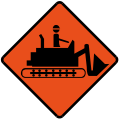 Heavy vehicles turning ahead
Heavy vehicles turning ahead.svg.png) Layout of lanes ahead
Layout of lanes ahead Layout of lanes ahead
Layout of lanes ahead Road narrows on right ahead
Road narrows on right ahead Temporary mandatory speed limit (40km/h)
Temporary mandatory speed limit (40km/h) Traffic lights in use ahead
Traffic lights in use ahead Bend to right (Left if symbol is reversed)
Bend to right (Left if symbol is reversed).svg.png) Supplementary plate to specify direction indicated for temporary road rule
Supplementary plate to specify direction indicated for temporary road rule Single lane traffic
Single lane traffic Curve Alignment Marker (Bend to direction indicated)
Curve Alignment Marker (Bend to direction indicated) Detour for pedestrians in direction indicated (Right)
Detour for pedestrians in direction indicated (Right) Advance sign of detour ahead
Advance sign of detour ahead Detour in direction indicated at junction (Right)
Detour in direction indicated at junction (Right)
Directional signs
- Signs indicating destinations reached via expressways have white lettering on a blue background.
- Signs indicating destinations reached via other roads have white lettering on a green background.
- Signs indicating local destinations have black lettering on a white background.
- Signs indicating recreational facilities and landmarks have white lettering on a brown background.
 On approach to a junction (single direction)
On approach to a junction (single direction) On approach to a junction (top white plate indicates name of the road crossed at the junction)
On approach to a junction (top white plate indicates name of the road crossed at the junction) At the junction
At the junction On approach to a roundabout
On approach to a roundabout On approach to exit junctions on an expressway
On approach to exit junctions on an expressway At a numbered exit junction on an expressway
At a numbered exit junction on an expressway Get in lane with respect to the destinations stated above each downward-pointing lane arrow
Get in lane with respect to the destinations stated above each downward-pointing lane arrow Direction to local destination
Direction to local destination Direction to place of interest
Direction to place of interest Direction to place of interest, as part of another sign
Direction to place of interest, as part of another sign
Road markings
Along the side of the road
 No parking between 7 am to 7 pm (Daily with the exception of Sundays and Public Holidays)
No parking between 7 am to 7 pm (Daily with the exception of Sundays and Public Holidays) No parking at any time, unless there are signs that specifically indicate seasonal restrictions.
No parking at any time, unless there are signs that specifically indicate seasonal restrictions. No waiting at any time, unless there are signs that specifically indicate seasonal restrictions.
No waiting at any time, unless there are signs that specifically indicate seasonal restrictions. Clearway (No stopping) on that side of the road at any time
Clearway (No stopping) on that side of the road at any time Indication of a zebra crossing ahead. See Zebra Crossing rules below.
Indication of a zebra crossing ahead. See Zebra Crossing rules below. Edge line (used along roads not in built-up areas, or divide the road shoulder of an expressway from the inside lane)
Edge line (used along roads not in built-up areas, or divide the road shoulder of an expressway from the inside lane)
Road dividers
 Keep left of the divider
Keep left of the divider Keep left of the diagonally hatched divider
Keep left of the diagonally hatched divider Keep left of the divider; no waiting on either side of the road at any time
Keep left of the divider; no waiting on either side of the road at any time Keep left of the unbroken diagonally hatched divider; No crossing of the divider
Keep left of the unbroken diagonally hatched divider; No crossing of the divider Keep left of the divider; no stopping and no crossing of the divider in either direction at any time.
Keep left of the divider; no stopping and no crossing of the divider in either direction at any time. Zebra crossing ahead; keep left of the divider. See Zebra Crossing rules below.
Zebra crossing ahead; keep left of the divider. See Zebra Crossing rules below.
Zebra crossing rules

Two flashing amber beacons are positioned, one on each side of the road, at a zebra crossing, which flashes from 7 pm to 7 am daily, indicating to an approaching motorist of a zebra crossing. Older crossings display the blue square zebra crossing signs on both sides (see above), which are synonymous to the flashing amber beacons, and are valid yet uncommon on the roads. The road markings and road dividers are white zig zag lines that indicate a zebra crossing in the vicinity.
On approach, regardless of the absence of any pedestrians, all motorists are required to keep left of the divider, prepare to stop and stay in their respective lanes, i.e. no overtaking is permitted.
When pedestrians are present at the side of a zebra crossing, all motorists are obligated to give priority to pedestrians crossing the zebra crossing bars, by stopping before the white line across the lane. No waiting is permitted within the vicinity of the zebra crossing.
A sign indicating a pedestrian crossing or a 'SLOW' painted on the road may be present as well.
References
- Singapore Official Highway Code (Basic Theory of Driving) Seventh Edition. ISBN 978-981-04-0567-0 . Published 2008 by Pacific Communications Pte Ltd under the authority of the Traffic Police.